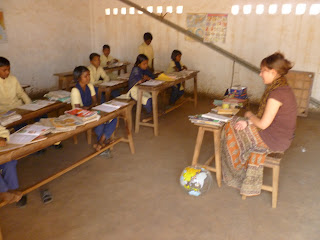After almost two months, I finally found the time to write about my experience at Dakshinayan in April 2011. Since I returned, I have been asked many times if I enjoyed the project and could recommend it. During the first few days, I kept answering that I would have preferred more school work with the kids and less free time. But now I realize that both components are very important for the experience.
Working with the children at Dakshinayan is very rewarding because they are so eager to learn. I can’t imagine kids in Austria asking for spelling tests! I taught English and sometimes geography and in case the students behaved well and had good results, we played games which we all enjoyed. Mitali was so kind to travel to the project with me so I could watch her teach and also get some advice from her (I had no previous experience). Since I taught classes 3 and 4 at the same time, it was always a bit of a challenge to find assignments for the kids while I was in the other classroom. I found it very effective to be a kind and friendly teacher if they worked well during my absence. If I found them chatting or playing while I was gone, I would be strict and less friendly for the rest of the day. You should make this very clear from the beginning to ensure a good cooperation.
As I mentioned before, not only teaching makes the Dakshinayan project so unique. After 11 a.m. you’re basically free to do whatever you want until you go to bed at around 8 or 9 p.m. – this may at first sound like a very, very long time. Especially if you’re used to watching TV all the time, constantly checking your e-mails and spending more time on Facebook than in the real world. This is exactly what makes Dakshinayan so great, because you can be free from all of these influences. It’s hard at first, but you get used to having a lot of time with little to do. Set a few activity milestones (e.g. tea at 4 p.m.). In the meantime, your mind wanders and you find yourself thinking of the same things over and over again. This lets you realize what is important to you, what you miss from home, what you are grateful for in your life etc.
Also you have the time to do things you would probably never do at home like building mosquito net hangers with a bunch of sticks, watching ant colonies, listening to birds in trees, doing yoga at sunrise or worshipping the statue of a Hindu saint. It’s the feeling of slowing down in an accelerating world. It lets you realize how simple life can actually be, even if it’s only for a few weeks.
Now enough of all this philosophical stuff, here are some of my tips from the practical side of every day life:
- Get up extra early at least once to watch the sunrise and how nature awakes.
- Especially if you’re the only volunteer, write a diary to process your thoughts and of course as a great souvenir to read again a few decades later.
- If you come during the hot season, reduce your physical activities to a minimum. Whatever you do at 40°C is exhausting! Indians’ advice: Sleep at noon, so you don’t feel the heat.
- You should better come to terms with eating rice and potatoes for several weeks. This was one of my major problems – I’m not a big fan of either and felt the lack of vitamines after a few days, also I lost about 10kgs there. But I started taking vitamine pills, that made me feel better.
- Drink a LOT. I often drank 4 liters in one day, your body needs it! Also think about using water purification tablets, just to be sure. I also sometimes drank the unfiltered water without any problems, but if you have a sensitive stomach, maybe you shouldn’t risk it.
- There is a computer with Internet available at the project. You should resist using it, just keep your family and friends updated every once in a while, but don’t spend precious time doing things you do at home.
- Think about games you enjoyed playing when you were young and play them with the kids as a motivation/reward for good work. They will love it and so will you.
- Go and visit the villages with the teachers. You will probably not understand much of what is discussed, but it’s fascinating to see how the people live and how hospitable they are.
- A great icebreaker and pass-time is to take pictures and show them on your camera display. But once you start, it's hard to stop. "Guruji, one photo!"
- You can recharge your phone, camera etc. – no need to bring extra batteries. Don’t forget a flashlight and a swiss army knife.
I’m sure I forgot a lot of things and also I don’t want to write a huge article filled with details and things you might want to know. Actually, it’s a big part of the experience to not know everything beforehand. But of course, if you have any questions, feel free to contact me on Facebook, I would be more than happy to help you.
To finish up, I would like to thank Siddharth and all the others involved for creating this great project and giving me the possibility to participate. I can say that Dakshinayan will probably never leave me. I think of it every day. It changed how I see many things. It helped me understand what is really important to me. I’m sure in many years I will look back and smile.
Now it’s your turn.










